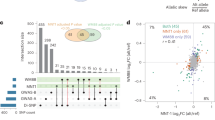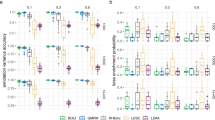Abstract
Human pigmentation traits are of great interest to many research areas, from ancient DNA analysis to forensic science. We developed a gene-based predictive model for pigmentation phenotypes in a realistic target population for forensic case work from Northern Germany and compared our model with those brought forth by previous studies of genetically more heterogeneous populations. In doing so, we aimed at answering the following research questions: (1) do existing models allow good prediction of high-quality phenotypes in a genetically similar albeit more homogeneous population? (2) Would a model specifically set up for the more homogeneous population perform notably better than existing models? (3) Can the number of markers included in existing models be reduced without compromising their predictive capability in the more homogenous population? We investigated the association between eye, hair and skin colour and 12 candidate single-nucleotide polymorphisms (SNPs) from six genes. Our study comprised two samples of 300 and 100 individuals from Northern Germany. SNP rs12913832 in HERC2 was found to be strongly associated with blue eye colour (odds ratio=40.0, P<1.2 × 10−4) and to yield moderate predictive power (AUC: 77%; sensitivity: 90%, specificity: 63%, both at a 0.5 threshold for blue eye colour probability). SNP associations with hair and skin colour were weaker and genotypes less predictive. A comparison with two recently published sets of markers to predict eye and hair colour revealed that the consideration of additional SNPs with weak-to-moderate effect increased the predictive power for eye colour, but not for hair colour.
Similar content being viewed by others
Log in or create a free account to read this content
Gain free access to this article, as well as selected content from this journal and more on nature.com
or
References
Armstrong BK, Kricker A : The epidemiology of UV induced skin cancer. J Photochem Photobiol B 2001; 63: 8–18.
Han J, Colditz GA, Hunter DJ : Risk factors for skin cancers: a nested case-control study within the Nurses' Health Study. Int J Epidemiol 2006; 35: 1514–1521.
Cullington HE : Light eye colour linked to deafness after meningitis. BMJ 2001; 322: 587.
Rasmussen M, Li Y, Lindgreen S et al: Ancient human genome sequence of an extinct Palaeo-Eskimo. Nature 2010; 463: 757–762.
Bouakaze C, Keyser C, Crubezy E, Montagnon D, Ludes B : Pigment phenotype and biogeographical ancestry from ancient skeletal remains: inferences from multiplexed autosomal SNP analysis. Int J Legal Med 2009; 123: 315–325.
Draus-Barini J, Walsh S, Pospiech E et al: Bona fide colour: DNA prediction of human eye and hair colour from ancient and contemporary skeletal remains. Investig Genet 2013; 4: 3.
Kayser M, Schneider PM : DNA-based prediction of human externally visible characteristics in forensics: motivations, scientific challenges, and ethical considerations. Forensic Sci Int Genet 2009; 3: 154–161.
Walsh S, Lindenbergh A, Zuniga SB et al: Developmental validation of the IrisPlex system: determination of blue and brown iris colour for forensic intelligence. Forensic Sci Int Genet 2011; 5: 464–471.
Sturm RA : Molecular genetics of human pigmentation diversity. Hum Mol Genet 2009; 18: R9–17.
Branicki W, Brudnik U, Wojas-Pelc A : Interactions between HERC2, OCA2 and MC1R may influence human pigmentation phenotype. Ann Hum Genet 2009; 73: 160–170.
Candille SI, Absher DM, Beleza S et al: Genome-wide association studies of quantitatively measured skin, hair, and eye pigmentation in four European populations. PLoS One 2012; 7: e48294.
Rees JL : Genetics of hair and skin color. Annu Rev Genet 2003; 37: 67–90.
Sturm RA, Frudakis TN : Eye colour: portals into pigmentation genes and ancestry. Trends Genet 2004; 20: 327–332.
Clark P, Stark AE, Walsh RJ, Jardine R, Martin NG : A twin study of skin reflectance. Ann Hum Biol 1981; 8: 529–541.
Duffy DL, Montgomery GW, Chen W et al: A three-single-nucleotide polymorphism haplotype in intron 1 of OCA2 explains most human eye-color variation. Am J Hum Genet 2007; 80: 241–252.
Eiberg H, Troelsen J, Nielsen M et al: Blue eye color in humans may be caused by a perfectly associated founder mutation in a regulatory element located within the HERC2 gene inhibiting OCA2 expression. Hum Genet 2008; 123: 177–187.
Sturm RA, Duffy DL, Zhao ZZ et al: A single SNP in an evolutionary conserved region within intron 86 of the HERC2 gene determines human blue-brown eye color. Am J Hum Genet 2008; 82: 424–431.
Kayser M, Liu F, Janssens AC et al: Three genome-wide association studies and a linkage analysis identify HERC2 as a human iris color gene. Am J Hum Genet 2008; 82: 411–423.
Visser M, Kayser M, Palstra RJ : HERC2 rs12913832 modulates human pigmentation by attenuating chromatin-loop formation between a long-range enhancer and the OCA2 promoter. Genome Res 2012; 22: 446–455.
Valverde P, Healy E, Jackson I, Rees JL, Thody AJ : Variants of the melanocyte-stimulating hormone receptor gene are associated with red hair and fair skin in humans. Nat Genet 1995; 11: 328–330.
Sulem P, Gudbjartsson DF, Stacey SN et al: Genetic determinants of hair, eye and skin pigmentation in Europeans. Nat Genet 2007; 39: 1443–1452.
Han J, Kraft P, Nan H et al: A genome-wide association study identifies novel alleles associated with hair color and skin pigmentation. PLoS Genet 2008; 4: e1000074.
Sulem P, Gudbjartsson DF, Stacey SN et al: Two newly identified genetic determinants of pigmentation in Europeans. Nat Genet 2008; 40: 835–837.
Liu F, Wollstein A, Hysi PG et al: Digital quantification of human eye color highlights genetic association of three new loci. PLoS Genet 2010; 6: e1000934.
Soejima M, Koda Y : Population differences of two coding SNPs in pigmentation-related genes SLC24A5 and SLC45A2. Int J Legal Med 2007; 121: 36–39.
Kayser M, de Knijff P : Improving human forensics through advances in genetics, genomics and molecular biology. Nat Rev Genet 2011; 12: 179–192.
Tully G : Genotype versus phenotype: human pigmentation. Forensic Sci Int Genet 2007; 1: 105–110.
Spichenok O, Budimlija ZM, Mitchell AA et al: Prediction of eye and skin color in diverse populations using seven SNPs. Forensic Sci Int Genet 2011; 5: 472–478.
Branicki W, Liu F, van Duijn K et al: Model-based prediction of human hair color using DNA variants. Hum Genet 2011; 129: 443–454.
Walsh S, Liu F, Ballantyne KN, van Oven M, Lao O, Kayser M : IrisPlex: a sensitive DNA tool for accurate prediction of blue and brown eye colour in the absence of ancestry information. Forensic Sci Int Genet 2011; 5: 170–180.
Fitzpatrick TB : The validity and practicality of sun-reactive skin types I through VI. Arch Dermatol 1988; 124: 869–871.
Walsh PS, Metzger DA, Higuchi R : Chelex 100 as a medium for simple extraction of DNA for PCR-based typing from forensic material. Biotechniques 1991; 10: 506–513.
Giardina E, Pietrangeli I, Martinez-Labarga C et al: Haplotypes in SLC24A5 gene as ancestry informative markers in different populations. Curr Genomics 2008; 9: 110–114.
Mengel-From J, Borsting C, Sanchez JJ, Eiberg H, Morling N : Human eye colour and HERC2, OCA2 and MATP. Forensic Sci Int Genet 2010; 4: 323–328.
R Development Core Team R: A Language and Environment for Statistical Computing. Vienna, Austria: R Foundation for Statistical Computing, 2009.
Warnes G, Gorjanc G, Leisch F, Man M genetics: Population Genetics. R package version 1.3.4 2008.
Venables WN, Ripley BD : Modern Applied Statistics with S 4th edn.New York: Springer, 2002.
Werft W, Benner A, Potter DM glmperm: Inference in Generalized Linear Models. R package version 1.0-5 2013.
Brasil P DiagnosisMed: Diagnostic test accuracy evaluation for medical professionals. R package version 0.2.3 2010.
Robin X, Turck N, Hainard A et al: pROC: an open-source package for R and S+ to analyze and compare ROC curves. BMC Bioinformatics 2011; 12: 77.
So HC, Gui AH, Cherny SS, Sham PC : Evaluating the heritability explained by known susceptibility variants: a survey of ten complex diseases. Genet Epidemiol 2011; 35: 310–317.
Faul F, Erdfelder E, Buchner A, Lang A-G : Statistical power analyses using G*Power 3.1: tests for correlation and regression analyses. Behav Res Methods 2009; 41: 1149–1160.
Novembre J, Johnson T, Bryc K et al: Genes mirror geography within Europe. Nature 2008; 456: 98–101.
Lao O, Lu TT, Nothnagel M et al: Correlation between genetic and geographic structure in Europe. Curr Biol 2008; 18: 1241–1248.
Steffens M, Lamina C, Illig T et al: SNP-based analysis of genetic substructure in the German population. Hum Hered 2006; 62: 20–29.
Walsh S, Wollstein A, Liu F et al: DNA-based eye colour prediction across Europe with the IrisPlex system. Forensic Sci Int Genet 2012; 6: 330–340.
Liu F, van Duijn K, Vingerling JR et al: Eye color and the prediction of complex phenotypes from genotypes. Curr Biol 2009; 19: R192–R193.
Pneuman A, Budimlija ZM, Caragine T, Prinz M, Wurmbach E : Verification of eye and skin color predictors in various populations. Leg Med (Tokyo) 2012; 14: 78–83.
Ruiz Y, Phillips C, Gomez-Tato A et al: Further development of forensic eye color predictive tests. Forensic Sci Int Genet 2013; 7: 28–40.
Walsh S, Liu F, Wollstein A et al: The HIrisPlex system for simultaneous prediction of hair and eye colour from DNA. Forensic Sci Int Genet 2013; 7: 98–115.
Cook NR : Use and misuse of the receiver operating characteristic curve in risk prediction. Circulation 2007; 115: 928–935.
Hand DJ, Anagnostopoulos C : When is the area under the receiver operating characteristic curve an appropriate measure of classifier performance? Pattern Recogn Lett 2013; 34: 492–495.
Lu TT, Lao O, Nothnagel M et al: An evaluation of the genetic-matched pair study design using genome-wide SNP data from the European population. Eur J Hum Genet 2009; 17: 967–975.
Acknowledgements
We thank all participants in our study. We thank Thomas Scholz for technical assistance and Mrs Tina Hagen-Hurley for revising the English text. Melanie Harder received additional support from the Graduate School ‘Human Development in Landscapes’ at the Christian-Albrechts University of Kiel.
Author information
Authors and Affiliations
Corresponding author
Ethics declarations
Competing interests
The authors declare no conflict of interest.
Additional information
Supplementary Information accompanies this paper on European Journal of Human Genetics website
Supplementary information
Rights and permissions
About this article
Cite this article
Caliebe, A., Harder, M., Schuett, R. et al. The more the merrier? How a few SNPs predict pigmentation phenotypes in the Northern German population. Eur J Hum Genet 24, 739–747 (2016). https://doi.org/10.1038/ejhg.2015.167
Received:
Revised:
Accepted:
Published:
Issue date:
DOI: https://doi.org/10.1038/ejhg.2015.167



